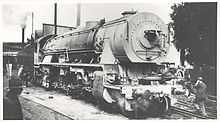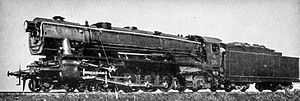New South Wales D57 class locomotive
| New South Wales D57 class | |
|---|---|
|
Class D57 Locomotive | |
| Type and origin | |
| Power type | Steam |
| Builder | Clyde Engineering, Granville |
| Build date | 1929/30 |
| Total produced | 25 |
| Specifications | |
| Configuration | 4-8-2 |
| UIC classification | 2'D1'h3 |
| Gauge | 4 ft 8 1⁄2 in (1,435 mm) standard gauge |
| Driver diameter | 5 ft 0 in (1.524 m) |
| Axle load | 24ton |
| Weight on drivers | 212,000 lb (96,000 kg) |
| Locomotive weight | 311,000 lb (141,000 kg) |
| Fuel type | Coal |
| Boiler pressure | 200 psi (1,379 kPa) |
| Firegrate area | 65 sq ft (6.0 m2) |
| Heating surface: – Total | 3,390 sq ft (315 m2) |
| Superheater area | 775 sq ft (72.0 m2) |
| Cylinders | Three |
| Cylinder size | 23.25 in × 28 in (591 mm × 711 mm) |
| Valve gear | Gresley conjugated |
| Performance figures | |
| Tractive effort | 64,327 lbf (286.1 kN) |
| Factor of adhesion | 3.82 |
| Career | |
| Operator(s) | New South Wales Government Railways |
| Class | D57 |
| Number(s) | 5701–5725 |
| Nicknames | Lazy Lizzies |
| Withdrawn | 1957–1961 |
| Disposition | 1 preserved, 24 scrapped |
The D57 class was a class of 4-8-2 steam locomotives built by Clyde Engineering for the New South Wales Government Railways in Australia. The tenders were built by Mort's Dock.
Introduction
The locomotives were among the heaviest of locomotives in Australia with a 24-long-ton (24.4 t; 26.9-short-ton) axle load and this along with their width restricted their sphere of operation to Thirroul on the Illawrra line, Wallerawang on the Main Western line and Junee on the Main South line.[1][2][3]
They had the highest tractive effort of any conventional engines used in Australia and were of approximately equal capability to the 60 class Garratt locomotives. They were very reliable and had the nickname Lazy Lizzies because they made heavy workings seem effortless.[4] Another nickname was bestowed on the class, Chuckling Charlies due to their syncopated exhaust beat.[5]
The three cylinder design fitted to the class gave it a distinctive off-beat exhaust sound when climbing upgrade. This design was also fitted to the 58 class. However, a couple of features, such as the Gresley conjugating valve gear fitted to these locomotives has been the source of debate as to its efficiency.[6]
Demise and Preservation
The first was withdrawn in October 1957, the last in October 1961.
The last example in traffic was saved for preservation:
| Preserved D57 Class Locomotives | ||||||||
|---|---|---|---|---|---|---|---|---|
| No. | Description | Manufacturer | Year | Current Organisation | Location | Status | Ref | |
| 5711 | 4-8-2 goods | Clyde Engineering | 1929 | NSW Rail Transport Museum | Valley Heights | static exhibit | NSW Locomotive, Steam 5711 | |
Gallery
-

5701 departing Clyde Engineering for a trial run to Penrith
-

5712 at Soldiers Bank near Mount Victoria
See also
References
- ↑ "King's of the Road" Roundhouse October 1979 page 23
- ↑ Oberg, Leon (1984). Locomotives of Australia 1850's - 1980's. Frenchs Forest: Reed Books. p. 157. ISBN 0 730100 05 7.
- ↑ Grunbach, Alex (1989). A Compendium of New South Wales Steam Locomotives. Sydney: Australian Railway Historical Society, NSW Division. pp. 201–209. ISBN 0 909650 27 6.
- ↑ Oberg, Leon (February 1974). "The End of the 57-Class Locomotives". Australian Railway Historical Society Bulletin: pp.29–30.
- ↑ ±Locomotives, A Guide, written by Gifford Eardley
- ↑ Slee, David E (January 2000). "D57 and D58 Classes—Design Differences and Power Comparisons". Australian Railway Historical Society Bulletin: pp.3–19.
Further reading
- Belbin, Phil; Burke, David (1981), Full steam across the mountains, Sydney: Methuen Australia
| ||||||||||||||||||||||||||||||||||||||
